Henry IV, Part 1
Henry IV, Part 1 is a history play by William Shakespeare, believed to have been written no later than 1597. It is the second play in Shakespeare's tetralogy dealing with the successive reigns of Richard II, Henry IV (two plays, including Henry IV, Part 2), and Henry V. Henry IV, Part 1 depicts a span of history that begins with Hotspur's battle at Homildon in Northumberland against Douglas late in 1402 and ends with the defeat of the rebels at Shrewsbury in the middle of 1403.[1] From the start, it has been an extremely popular play both with the public and critics.[2]
_-_1937.1171_-_Yale_University_Art_Gallery.jpg.webp)
Characters
|
Of the King's party
|
Rebels
Other Characters
Mentioned only
|
Synopsis
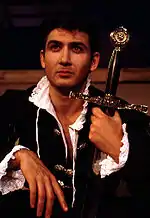
Henry Bolingbroke—now King Henry IV—is having an unquiet reign. His personal disquiet at the usurpation of his predecessor Richard II would be solved by a crusade to the Holy Land, but trouble on his borders with Scotland and Wales make leaving unwise. Moreover, he is increasingly at odds with the Percy family, who helped him to his throne, and Edmund Mortimer, the Earl of March, Richard II's chosen heir.
_Royal_Shakespeare_Theatre.jpg.webp)
Adding to King Henry's troubles is the behaviour of his son and heir, the Prince of Wales. Hal (the future Henry V) has forsaken the Royal Court to waste his time in taverns with low companions. This makes him an object of scorn to the nobles and calls into question his royal worthiness. Hal's chief friend and foil in living the low life is Sir John Falstaff. Fat, old, drunk, and corrupt as he is, he has a charisma and a zest for life that captivates the Prince.
The play features three groups of characters that interact slightly at first, and then come together in the Battle of Shrewsbury, where the success of the rebellion will be decided. First there is King Henry himself and his immediate council. He is the engine of the play, but usually in the background. Next there is the group of rebels, energetically embodied in Henry Percy ("Hotspur") and including his father, the Earl of Northumberland and led by his uncle Thomas Percy, Earl of Worcester. The Scottish Earl of Douglas, Edmund Mortimer and the Welshman Owen Glendower also join. Finally, at the centre of the play are the young Prince Hal and his companions Falstaff, Poins, Bardolph, and Peto. Streetwise and pound-foolish, these rogues manage to paint over this grim history in the colours of comedy.
As the play opens, the king is angry with Hotspur for refusing him most of the prisoners taken in a recent action against the Scots at Holmedon. Hotspur, for his part, would have the king ransom Edmund Mortimer (his wife's brother) from Owen Glendower, the Welshman who holds him. Henry refuses, berates Mortimer's loyalty, and treats the Percys with threats and rudeness. Stung and alarmed by Henry's dangerous and peremptory way with them, they proceed to make common cause with the Welsh and Scots, intending to depose "this ingrate and cankered Bolingbroke."[3] By Act II, rebellion is brewing.
.jpg.webp)
Meanwhile, Henry's son Hal is joking, drinking, and thieving with Falstaff and his associates. He likes Falstaff but makes no pretense at being like him. He enjoys insulting his dissolute friend and makes sport of him by joining in Poins' plot to disguise themselves and rob and terrify Falstaff and three friends of loot they have stolen in a highway robbery, purely for the fun of hearing Falstaff lie about it later, after which Hal returns the stolen money. Rather early in the play, in fact, Hal informs us that his riotous time will soon come to a close, and he will re-assume his rightful high place in affairs by showing himself worthy to his father and others through some (unspecified) noble exploits. Hal believes that this sudden change of manner will amount to a greater reward and acknowledgment of prince-ship, and in turn earn him respect from the members of the court.
_-_Dispute_between_Hotspur%252C_Glendower%252C_Mortimer_and_Worcester_(from_William_Shakespeare's_'Henry_IV_Part_I')_-_1947P6_-_Birmingham_Museums_Trust.jpg.webp)
The revolt of Mortimer and the Percys very quickly gives him his chance to do just that. The high and the low come together when the Prince makes up with his father and is given a high command. He vows to fight and kill the rebel Hotspur, and orders Falstaff (who is, after all, a knight) to take charge of a group of foot soldiers and proceed to the battle site at Shrewsbury.
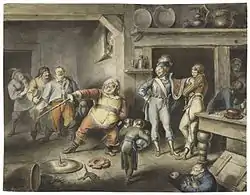
The battle is crucial because if the rebels even achieve a standoff their cause gains greatly, as they have other powers awaiting under Northumberland, Glendower, Mortimer, and the Archbishop of York. Henry needs a decisive victory here. He outnumbers the rebels,[4] but Hotspur, with the wild hope of despair, leads his troops into battle. The day wears on, the issue still in doubt, the king harried by the wild Scot Douglas, when Prince Hal and Hotspur, the two Harrys that cannot share one land, meet. Finally they will fight – for glory, for their lives, and for the kingdom. No longer a tavern brawler but a warrior, the future king prevails, ultimately killing Hotspur in single combat.
On the way to this climax, we are treated to Falstaff, who has "misused the King's press damnably",[5] not only by taking money from able-bodied men who wished to evade service but by keeping the wages of the poor souls he brought instead who were killed in battle ("food for powder, food for powder").[6] Left on his own during Hal's battle with Hotspur, Falstaff dishonourably counterfeits death to avoid attack by Douglas. After Hal leaves Hotspur's body on the field, Falstaff revives in a mock miracle. Seeing he is alone, he stabs Hotspur's corpse in the thigh and claims credit for the kill.[7] Though Hal knows better, he allows Falstaff his disreputable tricks. Soon after being given grace by Hal, Falstaff states that he wants to amend his life and begin "to live cleanly as a nobleman should do".[8]
_Royal_Shakespeare_Theatre.jpg.webp)

The play ends at Shrewsbury, after the battle. The death of Hotspur has taken the heart out of the rebels,[9] and the king's forces prevail. Henry is pleased with the outcome, not least because it gives him a chance to execute Thomas Percy, the Earl of Worcester, one of his chief enemies (though previously one of his greatest friends). Meanwhile, Hal shows off his kingly mercy in praise of valour; having taken the valiant Douglas prisoner, Hal orders his enemy released without ransom.[10] But the war goes on; now the king's forces must deal with the Archbishop of York, who has joined with Northumberland, and with the forces of Mortimer and Glendower. This unsettled ending sets the stage for Henry IV, Part 2.
Sources
Shakespeare's primary source for Henry IV, Part 1, as for most of his chronicle histories, was the second edition (1587) of Raphael Holinshed's Chronicles, which in turn drew on Edward Hall's The Union of the Two Illustrious Families of Lancaster and York.[11] Scholars have also assumed that Shakespeare was familiar with Samuel Daniel's poem on the civil wars.[11] Another source for this (and the following Henry plays) is the anonymous The Famous Victories of Henry V.
Date and text
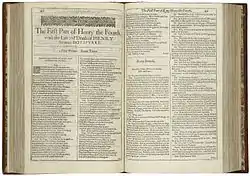
1 Henry IV was almost certainly in performance by 1597, given the wealth of allusions and references to the Falstaff character.[12] The earliest recorded performance occurred on the afternoon of 6 March 1600, when the play was acted at court before the Flemish Ambassador.[13] Other court performances followed in 1612 and 1625.
The play was entered into the Register of the Stationers Company on 25 Feb. 1598 and first printed in quarto later that year by stationer Andrew Wise. The play was Shakespeare's most popular printed text: new editions appeared in 1599, 1604, 1608, 1613, 1622, 1632, 1639, and 1692.
The Dering Manuscript
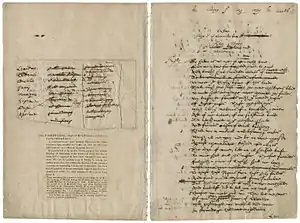
The Dering Manuscript, the earliest extant manuscript text of any Shakespeare play,[14] provides a single-play version of both Part 1 and Part 2 of Henry IV. The consensus of Shakespeare scholars is that the Dering MS. represents a redaction prepared around 1623, perhaps for family or amateur theatrics, by Edward Dering (1598–1644), of Surrenden Manor, Pluckley, Kent, where the manuscript was discovered. A few dissenters have argued that the Dering MS. may indicate that Shakespeare's Henry IV was originally a single play, which the poet later expanded into two parts to capitalise on the popularity of the Sir John Falstaff character. The Dering MS. is part of the collection of the Folger Shakespeare Library in Washington, D.C.[15]
Criticism and analysis

Themes and interpretations
At its first publication in 1597 or 1598 the play was titled The History of Henrie the Fourth and its title page advertised only the presence of Henry Percy and the comic Sir John Falstaff; Prince Hal was not mentioned. Indeed, throughout most of the play's performance history, Hal was staged as a secondary figure, and the stars of the stage, beginning with James Quin and David Garrick often preferred to play Hotspur. It was only in the twentieth century that readers and performers began to see the central interest as the coming-of-age story of Hal, who is now seen as the starring role.
In the "coming-of-age" interpretation, Hal's acquaintance with Falstaff and the tavern lowlife humanises him and provides him with a more complete view of life.[16] At the outset, Prince Hal seems to pale in comparison with the fiery Henry Percy, the young noble lord of the North (whom Shakespeare portrays considerably younger than he was in history in order to provide a foil for Hal). Many readers interpret the history as a tale of Prince Hal growing up, evolving into King Henry V,[17] perhaps the most heroic of all of Shakespeare's characters, in what is a tale of the prodigal son adapted to the politics of medieval England.[18] The low proportion of scenes featuring the title character, the king, has also been noted, with some authors suggesting that the play contrasts the authority of Henry IV, and his struggle to stay in control of the situation, with the chaotic forces of the rebels and Falstaff.
Oldcastle controversy
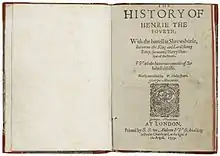
Henry IV, Part 1 caused controversy on its first performances in 1597, because the comic character now known as "Falstaff" was originally named "Oldcastle" and was based on John Oldcastle, a famous proto-Protestant martyr with powerful living descendants in England.
Although the character is called Falstaff in all surviving texts of the play, there is abundant external and internal evidence that he was originally called Oldcastle. The change of names is mentioned in seventeenth-century works by Richard James ("Epistle to Sir Harry Bourchier", c. 1625) and Thomas Fuller (Worthies of England, 1662). It is also indicated in details in the early texts of Shakespeare's plays. In the quarto text of Henry IV, Part 2 (1600), one of Falstaff's speech prefixes in Act I, Scene ii is mistakenly left uncorrected, "Old." instead of "Falst." In III, ii, 25-6 of the same play, Falstaff is said to have been a "page to Thomas Mowbray, Duke of Norfolk"—which was true of the historical Oldcastle. In Henry IV, Part 1, I, ii, 42, Prince Hal calls Falstaff "my old lad of the castle". An iambic pentameter verse line in Henry IV, Part 1 is irregular when using the name "Falstaff", but regular with "Oldcastle". Finally, there is the blatant disclaimer at the close of Henry IV, Part 2 that discriminates between the two figures: "for Oldcastle died [a] martyr, and this is not the man" (Epilogue, 29–32).
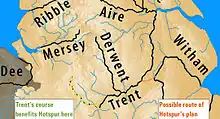
There is even a hint that Falstaff was originally Oldcastle in The Merry Wives of Windsor too. When the First Folio and quarto texts of that play are compared, it appears that the joke in V,v,85–90 is that Oldcastle/Falstaff incriminates himself by calling out the first letter of his name, "O, O, O!," when his fingertips are singed with candles—which of course works for "Oldcastle" but not "Falstaff." There is also the "castle" reference in IV,v,6 of the same play.[19]
The name change and the Epilogue disclaimer were required, it is generally thought, because of political pressure: the historical Oldcastle was not only a Protestant martyr, but a nobleman with powerful living descendants in Elizabethan England. These were the Lords Cobham: William Brooke, 10th Baron Cobham (died 6 March 1597), was Warden of the Cinque Ports (1558–97), Knight of the Order of the Garter (1584), and member of the Privy Council (1586–97); his son Henry Brooke, 11th Baron Cobham, was granted the paternal post of Warden of the Cinque Ports upon his father's death, and made a Knight of the Order of the Garter in 1599. Even more so, Frances Brooke, the 10th Baron's wife and 11th Baron's mother, was a close personal favourite of Her Majesty Queen Elizabeth I.
The elder Lord Cobham even had a strong negative impact upon the lives of Shakespeare and his contemporaries in the theatre. The company of actors formed by Shakespeare, Richard Burbage, Will Kempe and the others in 1594 enjoyed the patronage of Henry Carey, first Lord Hunsdon, then serving as Lord Chamberlain; they were, famously, the Lord Chamberlain's Men. When Carey died on 22 July 1596, the post of Lord Chamberlain was given to William Brooke, Lord Cobham, who definitely was not a friend to the players, and who withdrew what official protection they had enjoyed. The players were left to the mercies of the local officials of the City of London, who had long wanted to drive the companies of actors out of the city. Thomas Nashe, in a contemporary letter, complained that the actors were "piteously persecuted by the Lord Mayor and the aldermen" during this period. This interval did not last; when Cobham died less than a year later, the post of Lord Chamberlain went to Henry Carey's son George, 2nd baron Hunsdon, and the actors regained their previous patronage.[20]
The name was changed to "Falstaff", based on Sir John Fastolf, an historical person with a reputation for cowardice at the Battle of Patay, and whom Shakespeare had previously represented in Henry VI, Part 1. Fastolf had died without descendants, making him safe for a playwright's use.
Shortly afterward, a team of playwrights wrote a two-part play entitled Sir John Oldcastle, which presents a heroic dramatisation of Oldcastle's life and was published in 1600.
In 1986, the Oxford Shakespeare edition of Shakespeare's works rendered the character's name as Oldcastle, rather than Falstaff, in Henry IV, Part 1 (although not, confusingly, in Part 2), as a consequence of the editors' aim to present the plays as they would have appeared during their original performances. No other published editions have followed suit.
Adaptations

There have been three BBC television films of Henry IV, Part 1. In the 1960 mini-series An Age of Kings, Tom Fleming starred as Henry IV, with Robert Hardy as Prince Hal, Frank Pettingell as Falstaff and Sean Connery as Hotspur.[21] The 1979 BBC Television Shakespeare version starred Jon Finch as Henry IV, David Gwillim as Prince Hal, Anthony Quayle as Falstaff and Tim Pigott-Smith as Hotspur.[22] In the 2012 series The Hollow Crown, Henry IV, Part 1 was directed by Richard Eyre and starred Jeremy Irons as Henry IV, Tom Hiddleston as Prince Hal, Simon Russell Beale as Falstaff and Joe Armstrong as Hotspur.[23]
Orson Welles' Chimes at Midnight (1965) compiles the two Henry IV plays into a single, condensed storyline, while adding a handful of scenes from Henry V and dialogue from Richard II and The Merry Wives of Windsor. The film stars Welles himself as Falstaff, John Gielgud as King Henry, Keith Baxter as Hal, Margaret Rutherford as Mistress Quickly and Norman Rodway as Hotspur.
BBC Television's 1995 Henry IV also combines the two Parts into one adaptation. Ronald Pickup played the King, David Calder Falstaff, Jonathan Firth Hal and Rufus Sewell Hotspur.
Adapted scenes in flashback from Henry IV are included in the 1989 film version of Henry V (1989) with Robbie Coltrane portraying Sir John Falstaff and Kenneth Branagh playing the young Prince Hal.
Gus Van Sant's 1991 film My Own Private Idaho is loosely based on Part 1 of Henry IV, as well as Henry IV, Part 2 and Henry V.
The one-man hip-hop musical Clay is loosely based on Henry IV.[24]
In 2015 The Michigan Shakespeare Festival produced an award-winning combined production – directed and adapted by Janice L Blixt of the two plays[25] focusing on the relationship between Henry IV and Prince Hal.
In 2016, Graham Abbey combined Richard II and Henry IV, Part 1 into a single play called Breath of Kings: Rebellion. Henry IV, Part II and Henry V together became Breath of Kings: Redemption. Both adaptations were staged at the Stratford Festival in Stratford, Ontario. Abbey, in the productions, played Henry IV (Bolingbroke).
The 2016 app Cycle of Kings features the entire play Henry IV, Part 1 in interactive form, as well as a modern English translation.
In 2019, Netflix released the film The King, an adaptation of the play directed by David Michôd, and starring Timotheé Chalamet, Robert Pattinson, and Joel Edgerton.
Legacy
The famous Sherlock Holmes catchphrase "The game is afoot." is taken from Act I, Scene 3, line 615, where the Earl of Northumberland says: "Before the game is afoot, thou still let'st slip."
The phrase was also later used by Shakespeare in Henry V, Act III, Scene 1, by the title character:
- "I see you stand like greyhounds in the slips,
- Straining upon the start. The game's afoot:
- Follow your spirit, and upon this charge
- Cry 'God for Harry, England, and Saint George!"
Notes
- Saccio, pp. 47–50.
- Weil and Weil, p 1.
- Henry IV, Part 1, 1.3.137, in Bevington (1997).
- Henry IV, Part 1, 4.3.30, 4.4.19, in Bevington (1997).
- Henry IV, Part 1, 4.2.12, in Bevington (1997)
- Henry IV, Part 1, 4.2.64, in Bevington (1997).
- Henry IV, Part 1, 5.4.110ff., in Norton (2008).
- Henry IV, Part 1, 5.4.138ff., in Norton (2008).
- Henry IV, Part 1, 55.19, in Bevington (1997).
- Henry IV, Part 1, 5.5.28ff., in Norton (2008).
- Kastan 2002, p. 340.
- Weil and Weil, p. 4.
- Kastan 2002, pp. 54, 79.
- Leaving aside MS Harley 7368 of the British Library containing the text of the play Sir Thomas More if this play does indeed contain a contribution by Shakespeare. Folios 8-9a of that manuscript, which contain the part supposed to be by Shakespeare, have even been suggested to be a Shakespeare autograph. For further information see the Wikipedia article dedicated to the play.
- Halliday, Shakespeare Companion, p. 135.
- Bulman 2002, p. 171.
- Sanders 31.
- Duthie 141.
- Scoufos, Shakespeare's Typological Satire, p. 191.
- Halliday, Shakespeare Companion, p. 107; Scoufos, p. 99.
- "BFI Screenonline: An Age of Kings". Retrieved 4 July 2012.
- "BFI Screenonline: Henry IV Part 1 (1979)". Retrieved 4 July 2012.
- "Cultural Olympiad 2012: Shakespeare's History Plays", BBC Media Centre, 24 November 2011. Retrieved 2012-07-04.
- Jones, Kenneth (27 August 2008). "Matt Sax's Hip-Hop Musical 'Clay' Plays KC Prior to NYC". Playbill On-Line. Retrieved 10 September 2008.
- https://www.michiganshakespearefestival.com/past-productions
References
- Barker, Roberta. "Tragical-Comical-Historical Hotspur." Shakespeare Quarterly 54.3 (2003): 288–307.
- Bevington, David, ed. The Complete Works of Shakespeare. Updated Fourth Edition. University of Chicago, 1997.
- Bulman, James C. (2002). "Henry IV, Parts 1 and 2". In Hattaway, Michael (ed.). The Cambridge Companion to Shakespeare's History Plays. Cambridge Companions to Literature. Cambridge: Cambridge University Press. doi:10.1017/CCOL052177277X.010. ISBN 9781139000116 – via Cambridge Core.
- Duthie, George Ian. Shakespeare. London: Routledge, 1954.
- Greenblatt, Stephen. "Invisible Bullets: Renaissance Authority and Its Subversion in Henry IV and Henry V." In Political Shakespeare, edited by Jonathan Dollimore and Alan Sinfield, 18–47. 1985.
- Halliday, F. E. A Shakespeare Companion 1564–1964. Baltimore, Penguin, 1964.
- Saccio, Peter, Shakespeare's English Kings, 2nd edn, 2000.
- Sanders, Norman. "The True Prince and the False Thief." Shakespeare Survey 30 (1977).
- Weil, Herbert and Judith Weil, eds. The First Part of King Henry IV, 1997 (New Cambridge Shakespeare).
- Wright, Louis B, and Virginia A. LaMar, eds. The Folger Library General Reader's Shakespeare: Henry IV, Part I.
- Kastan, David Scott, ed. (2002). King Henry IV, Part 1. Third Series. Arden Shakespeare. ISBN 9781904271352.
External links
| Wikiquote has quotations related to: Henry IV, Part 1 |
| Wikisource has original text related to this article: |
- The First Part of Henry the Fourth A modern version of unspecified provenance.
- Henry the Fourth part 1 at Project Gutenberg.
 Henry IV, Part 1 public domain audiobook at LibriVox
Henry IV, Part 1 public domain audiobook at LibriVox
.png.webp)